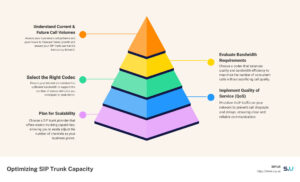
Do You Have Enough Internet Bandwidth for SIP Trunking?
 One of the most common questions we get when we talk to people about moving to SIP trunking for their business is, “Will my internet connection support SIP?” This is a really good question because the amount of available bandwidth can have a big impact on voice quality and the reliability of your communications infrastructure. The short answer is – probably. Most business internet connections these days are more than adequate to support dozens of concurrent calls. You can figure out if your network will suffice in just three easy steps.
One of the most common questions we get when we talk to people about moving to SIP trunking for their business is, “Will my internet connection support SIP?” This is a really good question because the amount of available bandwidth can have a big impact on voice quality and the reliability of your communications infrastructure. The short answer is – probably. Most business internet connections these days are more than adequate to support dozens of concurrent calls. You can figure out if your network will suffice in just three easy steps.
Step 1 – Determine the maximum number of concurrent calls
Every call puts a certain amount of demand on the network, so you need to think about how many inbound and outbound calls your business is likely to have at any one given time. (In addition to helping you determine whether you have enough bandwidth for SIP, this figure will also tell you how many SIP channels you need, which will impact your subscription price.) If your PBX provides call data records, you can use this information to find the number. If not, you can make a pretty good guess based on the number of employees and their level of phone activity. You likely don’t expect everyone in the office to be on the phone at the same time, so the number of current calls is probably less than the number of employees. As a general rule, companies have about one concurrent call for every 3- 4 employees.
Step 2 – Ask your SIP provider for the per-call bandwidth needs
There are several compression protocols, known as codecs, that are used to compress voice signals for digital processing. Each one requires a different amount of bandwidth. Any SIP trunking provider you consider should be able to tell you which codec they use and how much bandwidth it needs for each call. If you are considering SIP.US, we use the G.711 codec. It requires just 85kbps of bandwidth per call.
Step 3 – Do the math
Once you know the maximum number of current calls and the bandwidth needs for each call, all you need to do is multiply those two numbers to get the amount of bandwidth to support your voice needs. Keep in mind that other data will be traveling your network, so add at least 10% more to your calculation.
It is important to remember that the amount of bandwidth you experience in real life can be quite different than what your ISP advertises. To make sure your calculation is realistic, do a quick speed test from a computer on your network. There are several free, easy to use online tools including http://speedtest.net. It will report both your upload and download speeds. Use the lower of the two (usually upload). The tools give you the speed in Megabits per second (mpbs). Multiply that by 1000 to get Kilobits per second (kbps).
Here is a simple example:
Maximum number of concurrent calls expected: 8
Per call kbps (if you aren’t using SIP.us, ask your vendor): 85kbps
Total bandwidth needed: 8 x 85 = 680 kpbs
Upload speed: 2.35 mpbs x 1000 = 2350 kbps
The connection in this example is more than sufficient to support the number of expected calls and the rest of the company’s data needs.
This is typical. Most businesses with a T1, cable, DSL or metro ethernet connection have no difficulty leveraging SIP. Of course, we always recommend choosing a SIP trunking provider that offers a free trial so that you can test the service in your environment. If you have any concerns about how SIP trunking will work on your network, just let us know. We’re happy to chat.


